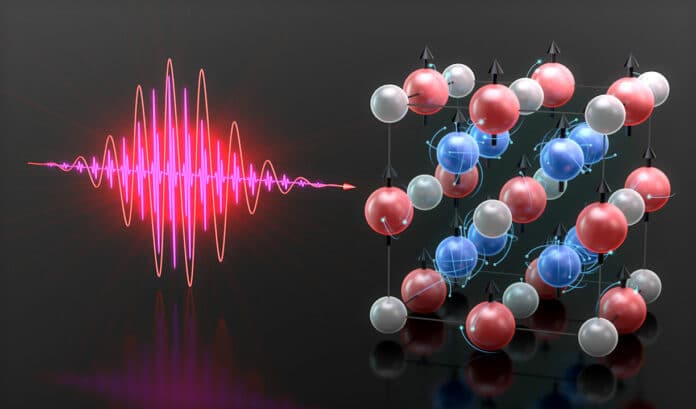More sophisticated manipulation of complicated materials and their spin states at short time scales will be needed to create the next generation of spintronic devices. But, a thorough understanding of the fundamental physics underpinning nanoscale spin manipulation is necessary to fully utilize these powers for more energy-efficient nanotechnologies.
The JILA team and colleagues from institutions in Sweden, Greece, and Germany investigated the spin dynamics within a unique substance known as a Heusler compound—a combination of metals that exhibits properties similar to those of a single magnetic material. In their investigation, the scientists used a cobalt, manganese, and gallium combination that acted as an insulator for electrons with downwardly oriented spins and a conductor for those with upwardly aligned spins.
Scientists used extreme ultraviolet high-harmonic generation (EUV HHG) light as a probe to track the re-orientations of the spins inside the compound after exciting it with a femtosecond laser. Tuning the color of the EUV HHG probe light is the key to accurately interpreting the spin re-orientations.
Co-first author and JILA graduate student Sinéad Ryan said, “In the past, people haven’t done this color tuning of HHG. Usually, scientists only measured the signal at a few different colors, maybe one or two per magnetic element at most.”
In a first for history, the JILA team precisely tracked the spin changes down to femtoseconds (a quadrillionth of a second) by tuning their EUV laser probe across the magnetic resonances of each element within the compound.
Ryan said, “On top of that, we also changed the laser excitation fluence, so we were changing how much power we used to manipulate the spins. By changing the power, we could influence the spin changes within the compound.”
Scientists used their novel approach to compare theoretical models of spin changes to their experimental data. They found a strong association between data and theory.
Ryan said, “We felt that we’d set a new standard with the agreement between the theory and the experiment.”
Extreme ultraviolet high-harmonic probes were an inventive tool that scientists used to delve into the spin dynamics of their Heusler compound. To create the probes, the scientists sent an 800-nanometer laser beam into a neon gas-filled tube. The laser’s electric field caused the electrons to be drawn and then pushed back from their atoms.
The electrons reacted like stretched rubber bands when they snapped back, ejecting purple flashes of light with a frequency (and energy) higher than the laser that had ejected them. To measure element-specific spin dynamics and magnetic behaviors within the material that the team might further modify, Ryan adjusted these bursts to resonate with the energies of the cobalt and manganese within the sample.
By adjusting the power of the excitation laser and the color (or photon energy) of their EUV probe, scientists could ascertain the predominant spin effects within their compound at different periods. They contrasted their findings with time-dependent density functional theory (TD-DFT), a sophisticated computer model. This model forecasts the moment-to-moment evolution of an electron cloud in a material upon exposure to different stimuli.
The TD-DFT framework reveals the agreement between the model and the experimental results because the Heusler compound has conflicting spin effects, such as spin transfers and flips up or down. Within a single element of the sample, the spins flip from one orientation to the other—from up to down and vice versa. On the other hand, as time passes, the spins of the various elements—in this case, cobalt and manganese—transfer among themselves, making each substance more or less magnetic.
Scientists noted, “What we found in the theory was that the spin flips were quite dominant on early timescales, and then the spin transfers became more dominant. Then, as time progressed, more de-magnetization effects take over, and the sample de-magnetizes.”
Scientists could better manipulate spins to give materials more potent magnetic and electrical properties by knowing which effects predominated at specific energy levels and times.
Journal Reference:
- Sinéad Ryan, Peter Johnsen et al. Optically controlling the competition between spin flips and intersite spin transfer in a Heusler half-metal on sub–100-fs time scales. Science Advances. DOI: 10.1126/sciadv.adi1428
